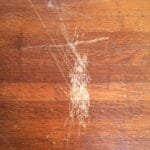Imagine relaxing at home, your favorite candle flickering gently, its aroma filling the room. But as you lean closer, you notice something’s off.
Instead of an even, glowing pool of wax, your candle has tunneled down the center, leaving wasted wax around the edges. Frustrating, right? Candle tunneling not only disrupts the aesthetic but also cheats you out of the full experience you deserve.
Don’t worry—you’re not alone, and there’s a solution. In this guide, you’ll discover simple yet effective strategies to fix candle tunneling, ensuring you get the most out of every burn. Ready to reclaim your candle’s full potential? Let’s dive in!

Credit: theforestrystudio.com
Causes Of Candle Tunneling
Candle tunneling happens when the wax burns unevenly, leaving wax around the edges. Poor wick size and incorrect burning time cause this issue. Fix it by letting the candle burn longer, allowing the wax to melt evenly.
Candle tunneling is a common issue that many candle enthusiasts encounter. It’s that frustrating moment when the wax burns down the center, leaving a ring of unmelted wax around the edge. This not only wastes the candle but also detracts from its aesthetic appeal. Understanding the causes of candle tunneling can help you enjoy a more even and longer-lasting burn. So, let’s explore what might be causing your candles to tunnel.Improper Wick Size
The wick is the heart of your candle. If it’s too small, it won’t generate enough heat to melt the wax evenly across the surface. A wick that’s too large, however, can cause the opposite problem. Think of it like choosing the right size of shoes—too small, and it’s uncomfortable; too large, and you can’t walk properly.First Burn Mistakes
Your first burn sets the stage for the rest of the candle’s life. If you don’t allow the wax to pool to the edge on the first burn, tunneling is likely to occur. Imagine reading the first chapter of a book and skipping the rest; you miss the full experience. Make sure to let your candle burn for at least one hour per inch of its diameter to create a full melt pool.Environmental Factors
The environment around your candle can significantly impact how it burns. Drafts, fans, or air conditioning can cause uneven burning. Have you ever noticed how a gentle breeze can sway a candle flame? Such disturbances can cause the candle to burn on one side more than the other, leading to tunneling.Poor Quality Wax
Not all waxes are created equal. Some low-quality waxes don’t melt as evenly, increasing the risk of tunneling. You wouldn’t use low-quality ingredients in a recipe you wanted to savor, right? Choosing a high-quality wax can make a big difference in how your candle burns.Uneven Surface
An uneven surface can cause the wax to pool on one side. If your candle isn’t on a flat surface, gravity will do its work, leading to an uneven burn. Have you ever tried to balance a book on an uneven table? The principles are surprisingly similar. Make sure to place your candle on a stable, flat surface for the best results. Understanding these causes empowers you to tackle candle tunneling effectively. Now, the next time you light a candle, you’ll know exactly what to look out for. What’s your most common candle tunneling culprit?
Credit: www.tiktok.com
Preventive Measures
Candle tunneling can be frustrating. But it can be avoided with simple steps. These preventive measures ensure your candles burn evenly and last longer.
Optimal Wick Size
Choosing the right wick size is crucial. A wick that’s too small can cause tunneling. It won’t melt the wax evenly. Check the manufacturer’s guide for the best wick size.
Proper Candle Burning Techniques
Let your candle burn long enough. The first burn is important. The wax should melt to the edges. This creates an even wax pool. Avoid short burn times. They lead to tunneling.
Choosing The Right Candle Holder
A proper candle holder helps. It supports the candle and catches drips. Ensure the holder is stable. It should fit the candle snugly. This helps maintain even burning.
Fixing Existing Tunneling
Candle tunneling can be frustrating. It leaves wax around the edges. Fixing existing tunneling is possible. Here are simple methods to rescue your candle. Each technique is easy and effective.
Rescue With Aluminum Foil
Wrap aluminum foil around the candle’s top. Leave an open space in the center. Light the candle and let it burn for a few hours. The heat will melt the wax evenly. This helps the candle correct itself.
Using Hair Dryer Method
Turn on your hair dryer. Use it to heat the wax. Focus on the hard wax edges. Melt them gently until even. Let the candle burn for a while. This fixes uneven surfaces.
Heat Gun Technique
A heat gun can be handy. Use it to melt the wax edges. Hold it at a safe distance. Move it in circular motions. The wax will soften and level. Let the candle burn fully to finish.
Understanding Candle Anatomy
Candle tunneling can frustrate many candle lovers. It often happens due to uneven burning. Understanding the anatomy of a candle helps in solving this issue.
Candles consist of wax, a wick, and sometimes fragrance oils. Each element plays a role in how a candle burns. Let’s explore how these components affect candle performance.
Wax Types And Their Impact
Different wax types affect candle burning. Paraffin wax is common and affordable. It burns quickly and often leads to tunneling. Soy wax is natural and burns slower. It reduces the risk of tunneling.
Beeswax is another option. It burns clean and bright. It also tends to create a more even burn. Choosing the right wax can make a big difference.
Role Of Fragrance Oils
Fragrance oils add scent to candles. But they can impact burning behavior. Too much oil can cause an uneven burn. This can lead to tunneling.
Balance is key. Use the right amount of oil for an even burn. Test different amounts to find what works best. This helps in achieving a fragrant and tunnel-free candle.
Expert Tips For Candle Maintenance
Struggling with candle tunneling? Trim the wick to ¼ inch before each burn for an even melt. Let the wax pool reach the edge to prevent tunneling. Cover your candle with aluminum foil to help spread the heat evenly.
Are you tired of your candles burning unevenly, leaving a tunnel of wasted wax? Candle tunneling can be frustrating, but with a few expert tips, you can ensure your candles burn beautifully every time. These simple maintenance tricks can make a big difference in extending the life and enjoyment of your candles.Regular Trimming Of Wick
Keeping your candle wicks trimmed is essential. A wick that’s too long can cause a tall flame, which leads to uneven burning and tunneling. Ideally, the wick should be around 1/4 inch before each burn. I once neglected this simple step, and my favorite lavender candle developed a deep tunnel. It was a sad sight, and it taught me the importance of regular maintenance. So, grab a pair of scissors or a wick trimmer, and make it a habit.Avoiding Drafty Areas
Candles and drafts don’t mix well. A gust of wind or a breeze from an open window can cause the flame to flicker excessively. This uneven burning can lead to tunneling. Consider where you place your candles. Is it near a door, window, or vent? You might need to find a more sheltered spot. Your candle deserves a calm environment to shine its brightest.Storing Candles Properly
Proper storage is more important than you might think. Candles stored in direct sunlight or extreme temperatures can develop irregularities in the wax. This can lead to poor burning performance. Keep your candles in a cool, dry place. I once stored candles on a windowsill, and the heat from the sun caused them to warp. Lesson learned—store them in a cupboard or drawer to maintain their shape and quality. By incorporating these maintenance tips, you’re not just preserving your candles; you’re enhancing your relaxation experience. What changes can you make today to enjoy your candles more fully?:max_bytes(150000):strip_icc()/SPR-how-to-fix-candle-tunneling-8415797-01-5e2b1a0dd47d42eaaa97eebe9eda5f8e.jpg)
Credit: www.thespruce.com
When To Seek Professional Help
Candle tunneling can be frustrating. Sometimes, fixing it at home isn’t enough. When the issue persists, professional help might be needed. Understanding when to seek expert advice can save your candle.
Signs Of Irreparable Damage
Some tunneling issues cannot be fixed at home. Wax might not melt evenly. The wick could be too short. Maybe the candle won’t burn properly. These are signs of deeper problems. Sometimes, the candle wax is unevenly distributed. This makes home fixes ineffective.
Consulting Candle Specialists
Candle specialists have the right tools. They understand wax dynamics. Specialists can diagnose complex issues. They offer solutions for stubborn tunneling. Consulting them ensures your candle burns correctly. They might reshape the wax. Or adjust the wick size. Their expertise can save a favorite candle.
Frequently Asked Questions
What Causes Candle Tunneling?
Candle tunneling happens when wax burns down the center. The sides remain unmelted.
How Can I Prevent Candle Tunneling?
Burn the candle until the entire surface melts. This ensures even burning.
Can I Fix A Tunneled Candle?
Yes, you can fix it. Wrap foil around the top. Let it burn evenly.
How Long Should I Burn A Candle?
Burn for at least one hour. Or until the surface is fully melted.
Is Trimming The Wick Important?
Yes, trimming the wick prevents uneven burning. It also reduces smoke and soot.
Conclusion
Candle tunneling can be frustrating. But now, you know how to fix it. Trim your wick regularly. Use a foil wrap to even out the wax. Burn your candle for longer sessions. These steps help your candles burn evenly. Enjoy the full scent and light from your candles.
Practice makes perfect. Experiment with different techniques. Soon, your candles will burn beautifully. Let your home glow with warmth and fragrance. Keep your candles safe and clean. Share these tips with friends. Everyone deserves to enjoy their candles without tunneling.
Your candles will thank you!




